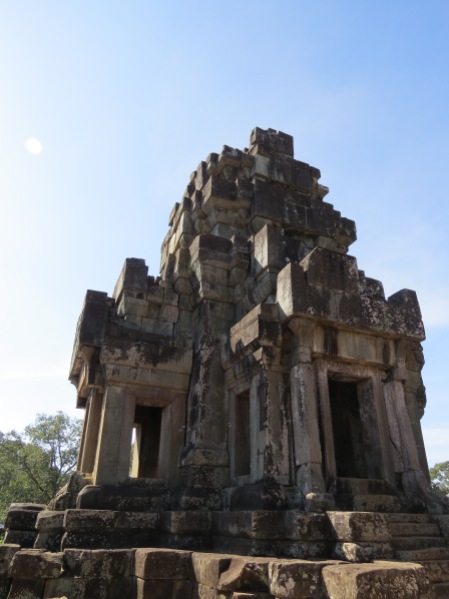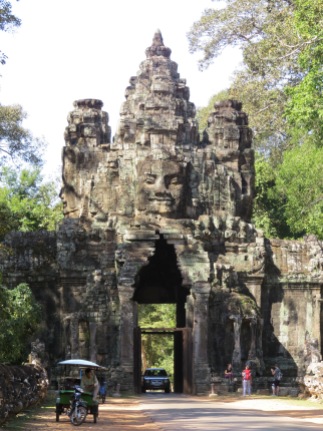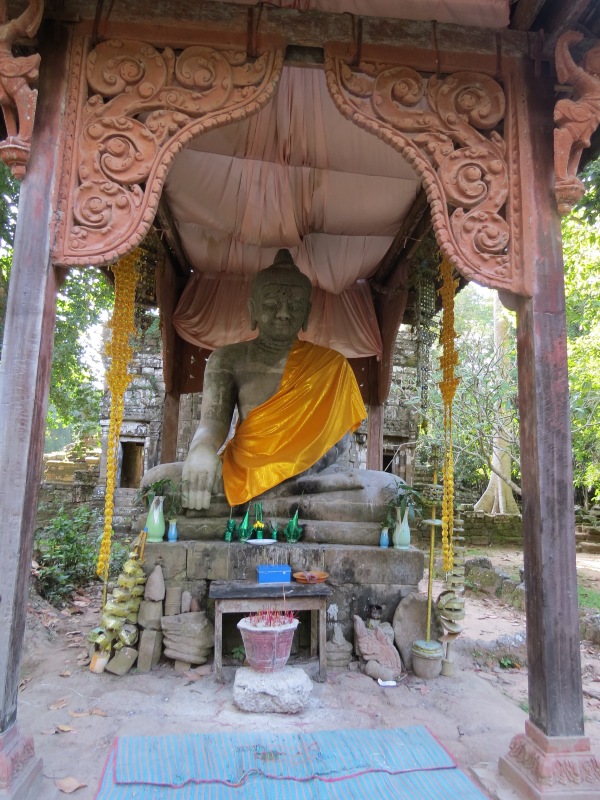Temples of the Forest.
We kicked off our exploration of Cambodia by attempting to escape from the touristy spots, disappearing off the main dirt path to find some solitude and romance in the temples of the forest. We were still able to view the magnificent scenery but without most of the pushy, selfie-taking, crowd-packed areas that quickly become annoying and make a journey less pleasurable.
Because of popular movies, such as Tomb Raider that are filmed in Cambodia, there has been a large influx of tourists to certain areas of this country. This is a great thing for the Cambodian economy, especially Siem Reap, a city that gains so much from the income of tourists. Yet sadly, temples can easily be overrun with foreigners taking pictures because “Angelina Jolie once walked through that doorway.” There is a certain solitude and appreciation for the ancient history and land that is forgotten or lost as more people flock here to cross things off their check-list.
While I highly recommend traveling to Cambodia, just remember: sit down, try to take a moment and absorb your surroundings, really take everything in! Don’t just worry about getting that next perfect Facebook profile picture or creating the craziest yoga pose deep in the temple grounds. Rather explore, enjoy the diverse environment, wondrous wildlife, and the richness of the sites!!
Deep into the Temples of the Forest
TA PROHM
Lets get one thing out of the way first… Yes, this is the site where part of the movie Tomb Raider, starring Angelina Jolie, was filmed. Even if she did put this place on the map (for it was filmed way before everything was fixed up for tourism), there are much more interesting reasons to make this temple a “must-see” on your adventure!
Ta Prohm has a push and pull relationship between human and nature. Great silk cotton trees intertwine meticulously throughout the temple stones, binding the structure together, but also creating a risk of it being torn apart. Ta Prohm is “an extraordinary fusion of nature and man.”
The threat of damage from falling trees and huge visitor footfall forced a new strategy of intervention to stabilize this site. There were early suggestions of cutting many of the trees which, of course, caused a worldwide uproar. Nevertheless, some large trees had to be taken down because they were endangering the structure and the network of wooden walkways provided to cope with the large number of tourists.

Ta Prohm is one of the few temples bearing an inscription detailing the indentured servants, 79,635 total! This included 18 high priests, 2,740 officials, 2,232 assistants, and 615 dancers. There was also an inventory of property including a set of gold plates weighing 5 tonnes, 35 diamonds, 40,620 pearls, 4,540 precious stones, 967 veils from China, 512 silk beds, and 523 parasols!
** In May 2012, Indian archaeologists excavating in front of the Hall of the Dancers found a statue of Buddha and then a golden crown weighing 5kg (11lbs.)!**
TA NEI
Unlike its larger well-known neighbors, this temple invites you to linger. Not far off of the beaten path, Ta Nei welcomes few visitors, partly because it is not easily accessible by vehicles and not as popular with foreigners. This is your own forest to explore! When we visited Ta Nei, we were literally the only people there at the time!
The remains of two moats can be spotted before entering the temple, which is an enchanting rubble of stones amidst stunning greenery. Ta Nei also features several notable pediments decorated with Buddhist inspired carvings that survived the Hindu reaction under Jayavarman VIII.
TA KEO
Ta Keo is the unfinished masterpiece of a young king, Jayavarman V. Jayavarman V was just 10 years old when he ascended to the throne! Yet, he quickly established his capitol and in the center of it, at age 17, he began a stunning state temple. It is now known as Ta Keo.
A massive 5-layered pyramid, this temple rises 22m (72ft) from ground level. Looking up inside the central sanctuaries you can see a prime example of the corbelling method used to create vaulted ceilings. Corbelling formed primitive arches by offsetting rectangular blocks and projecting each stone one third of its length from each side until the span between the walls is bridged with a single stone. This method was used extensively in Angkor temples, imposing strict limits on the spans they were able to bridge, and accounting for the narrow galleries and passageways of Khmer architecture.
Ta Keo is one of the grandest temple mountains at Angkor and is said to possibly have been one of the finest of all Angkor temples if only it were completed. There is no proof as to why the work stopped when the temple carving had just begun. There is an inscription that says lightening struck the temple, which the Khmer interpreted as a bad omen, therefore, all work ceased.
VICTORY GATE OF ANGKOR THOM
As you approach the 23m (75ft) high gate, you cross a wide causeway flanked on either side by 54 gods (devas) and 54 demons (asuras) pulling on a giant snake in a representation of the scene from the Hindu myth called Churning of the Ocean of Milk.
In this legend the gods and demons cooperate to create the nectar of life (amrita) that would render them immoral. Using Mount Mandara as a pivot and the serpent Vasuki as the cord, they churned until the mountain was on the verge of crashing into the sea. To help them, Vishnu, incarnated as the tortoise Kurma, bore the mountain on his back and recovered the amrita for the gods, who, once rejuvenated, finally defeated the demons. But more than the amrita was created by the churning and the ocean dispelled many other magical beings- including the apsaras, beautiful flying celestial female figures; the three-headed elephant; and mount of the Hindu god Indra.
DEATH GATE
Right in the middle of a tourist hub in Angkor, sits this impressive monument, yet, it is pretty much dead silent when you visit. There is no paved road leading up to the Death Gate, making it a perfect experience of Angkor architecture off the beaten path. We entered through the Victory Gate to walk along the 8m high laterite city wall to reach the Death Gate. Not a soul was to be seen… or any wildlife, thank goodness! 😉

TERRACE OF THE LEPER KING
The 300m (1000ft) long Elephant Terrace is a viewing platform from where the king and his retinue would view military parades and preside over other public functions of the state. The principal scene carved into the terrace is of elephants hunting under the guidance of their mahouts. They dominate the jungle and charge through the foliage using their trunks to fight off tigers that appear to leap out from behind the trees. Other times, they can be seen grabbing a cow or holding a man upside down. One scene shows elephants decked out for a royal procession led by the king and attended by his court.
PREAH PALILAY
Set in a quiet, forested area, you approach this sanctuary via an elegant cruciform terrace with naga balustrades and a Buddha statue that is still worshipped to this day. Completely surrounded by greenery, you fall into a place of serenity as you leisurely explore.
Preah Palilay boasts only a few of its original structures today. The central sanctuary contains an unusually high tower which still soars above you appearing to lean at an awkward angle, though the original structure reached even higher! Academic debate continues as to whether Preah Palilay was built before or after the so-called ‘iconoclasm’ of the mid-late 13th century, during which many Buddhist images were defaced or destroyed. Palilay still features some Theravadan Buddhist iconography, which either escaped the fury of the iconoclasts under Jayavarman VIII, or was added subsequent to the Hindu backlash against Buddhism.
PHIMEANAKAS
Immediately as you enter the forested area to reach Phimeanakas, the loud and constant chatter of birds begin ringing in your head. The sound has a way of making you feel like you have been transported to another world, perhaps somewhere walking alone through the depths of a jungle.
There is a fascinating local lore that exists with Phimeanakas: A guardian spirit in the form of a nine-headed serpent lived within the temple grounds. The spirit would take the form of a woman with whom the king had to sleep with every night before retiring to the apartments of his wife and concubines if he were to preserve the royal line. If he missed even one night, legend held that he would die without a successor.

It is still unclear as to what period and to which king to assign any discovery of Phimeanakas. Despite its crumbled state, you can still see the three-tiered pyramid form as you approach. Elephants once stood on pedestals on the corners of the base layer but today are broken. Lions guard the stairways leading to the sanctuary at the top of the temple. Two ponds likely served the royal household but have long since gone as well. The larger Royal Pond features a striking series of sculptured borders. Look for sea monsters, nagas, garudas, princes and princesses impressively carved in the side.
** In the early 1980’s, Phimeanakas became known as a good place to dig for gold. Vietnamese troops and local villagers dug a hole, carrying the soil to pan for gold in the Angkorian pool. The hole can still be seen today. In one unfortunate accident during that era, a large block of laterite tumbled down from the temple, crushing and burying 3 Vietnamese soldiers. Their bodies were never recovered.**
BAPHUON
A pyramid temple representing Mount Meru on Earth, Baphuon’s original construction would have looked immense. The primary structure runs 130m (426ft) from east to west and 100m (328ft) from south to north. The original tower shrine topped the temple at 50m (164ft) but has long since disappeared.

In the 1960’s, Baphuon developed a reputation as the world’s largest 3-dimensional jigsaw puzzle after experts adopted the anastylosis method for its restoration. This involves carefully taking apart the structure block by block to re-inforce the central foundations then putting the whole back together again!! In order to achieve this, each piece is carefully annotated and registered, providing the key to the final reconstruction. Some 300,000 stone blocks at Baphuon were labeled, dismantled, and laid out on the ground over 10 hectares so that the base of the structure could be reinforced!
The international restoration team was forced to abandon these efforts in the early 1970’s as Cambodia’s civil war intensified and the Khmer Rouge took power. When efforts recommenced in the 1990’s, plans for the labeled blocks could not be found and were assumed destroyed. In 1996, the final push to complete the temple started up again taking a huge team another 16 years to complete!! Each stone lying in the forest beside Baphuon was logged, compared, and matched to others to determine their relative position. One block in the wrong place would have thrown everything out of alignment! This jigsaw puzzle was returned to its near original form and re-opend in 2011.
From its origin in the 11th century Baphuon served as a Hindu shrine for several hundred years before being appropriated to Buddhism.
BAYON
With its iconic facade Bayon is unlike any other Cambodian temple and one of my absolute favorites! Bayon once consisted of around 200 enigmatically smiling stone faces carved into something in the order of 50 towers! But even with just the remaining 37 towers today, it’s still incredible and awe-inspiring!

The identity and meaning of the iconic face towers has divided scholarly opinion since the beginnings of research at Angkor. But locals generally refer to the faces as images of Phrom, the Khmer pronunciation of Brahma (the Hindu god of creation). The temple’s foundation inscription has never been found.

This three-tiered temple contains two galleries featuring extensive bas-reliefs. Bas-reliefs at Bayon depict scenes of Angkorian daily life and religious mythology. The outer gallery contains scenes of Khmer military prowess during battles waged both on land and sea, followed in the second section of the southern gallery by more commonplace vignettes of hunting, fishing, markets, festivals, cockfights, entertainers, ordinary family life, and palace dwellers. The eastern gallery, at the southern end, depicts the famous naval battles of 1177-1178 on the Tonle Sap Lake.
BENG MEALEA
This temple rests in a ruinous state, with several collapsed galleries and towers, but its large scale and very remote location make this jumble of stones an exciting place to visit. The similarity in layout to Angkor Wat has led many to believe that Beng Mealea may in fact be a blueprint for its more famous cousin. However, we now know that Beng Mealea was constructed after Angkor Wat but before the building frenzy of Jayavarman VII.
No inscriptions found thus far relate to Beng Mealea, so we don’t know for certain who built it and for what purpose. The temple was only reopened to visitors around 2003 after an extended de-mining effort.


**One of Beng Mealea’s central towers was demolished with high explosive during the Khmer Rouge period in the hunt for ancient treasure!**
–Historical information and a great read!: “The Angkor Guidebook. Your Essential Companion to the Temples,” by Andrew Booth–
Lindsay View All →
Our roots will forever be from here, America, born and raised. Yet, life requires us to move more frequently than we care to count. Whether living stateside or abroad, you can always find us traveling somewhere. We scout out places that you only think you can dream of one day seeing and we seek out those that aren’t found in guidebooks. We then bring them to life here in our travel memos, so hopefully, one day you too can visit them or at least be able to live vicariously through us. This blog isn’t just about crossing off places from a bucket list. It’s about absorbing and learning how other cultures grow and fit into the same world that we do. Life is short and the world is big. Enjoy and get out there!
















































































































































